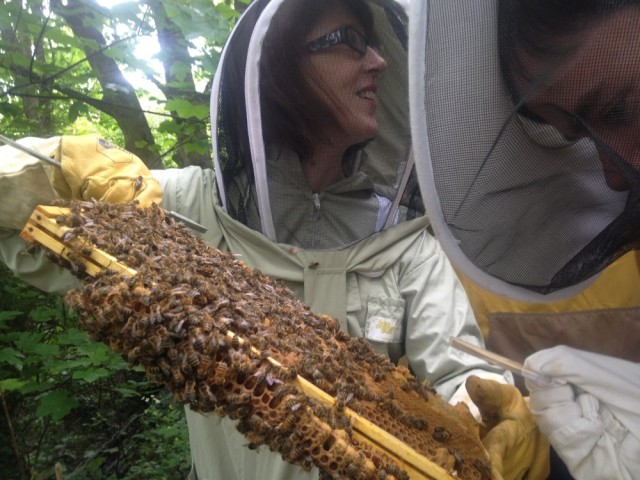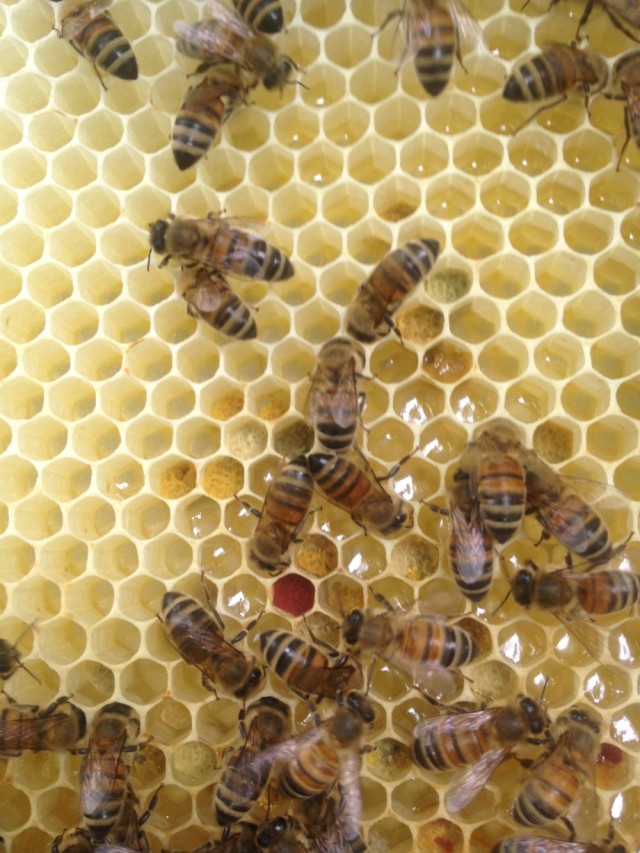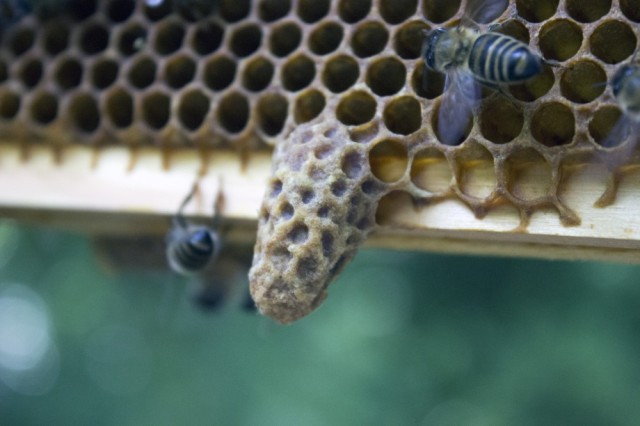Yesterday the apiary was buzzing… with beekeepers. Lots of chatting and laughing over tea, and buying of frames for rapidly expanding colonies. Emma and I got to show three completely new prospective beekeepers inside our hives – the first time they’d seen thousands of bees up close. They coped well, but kept their ungloved hands firmly in their pockets.
Here’s Emma going through the hive we bought from Charles recently. It was packed with brood. On the bottom you can see some of the drone comb the bees have been building. They’ve actually built the drone comb underneath several of the frames, making it very hard to inspect without having huge chunks of drone comb falling off.
Below Tom tries to use a magnifying glass to see eggs, the ends of his bee suit tightly curled round his fingers. I understand why beginners are afraid to have bees land on their hands, but these bees weren’t in attack mode and would have been very unlikely to sting him. If the bees are emitting a high pitched whine and bouncing off your veil, that’s the time to cover your hands up 🙂 Emma is wearing thick gloves because she has a bad reaction to stings.
The bees were finding some beautiful red-brick colour pollen. This could be from horse chestnut or blackthorn. We have rows of horse chestnut trees out around the apiary, their candle-like white flowers pointing upwards majestically.
Here are some fun UK sites for identifying pollen:
- Sheffield beekeepers have a Pollen chart, which is interactive with toggles for different seasons
- Bristol Beekeeping Association also have an interactive pollen guide, access by clicking on ‘Pollen guide’ along their top navigation menu
No more photos after this as we got kinda distracted on frame 6 by finding a couple of uncapped queen cells with larvae inside. Uh-oh!
Luckily, finding them uncapped is a good situation to be in, as it means the bees are unlikely to have swarmed yet. Generally (but being bees, of course not always!) they will leave on the day – or day after – the first queen cell is capped, which is day 8 after the egg was first laid. However, bad weather can delay the swarm leaving. But if we had waited till next weekend to take action, the cells would have been capped and our queen would probably have been high up in a tree somewhere.
So the beginners got to see some very exciting stuff as we tried to do some quick thinking. We consulted our Beecraft advice sheets on swarming, and tried to follow the advice within and our memories of artificial swarm techniques. Emma had her queen clip with her, so we put the queen inside that and laid her on top of the hive to keep the bees calm.
We had a spare nucleus box (always have a spare nuc!). Inside this we put four frames of brood, honey and pollen stores and a frame of partially drawn-out foundation – making sure none of these contained a queen cell. We then put our queen inside and shook bees in from a couple of frames in the old hive.
The old hive now contains a couple of queen cells, brood and honey stores. This recreates the aftermath of a swarm, so the reduced population will hopefully put the bees off swarming. Some beekeepers will say leaving two queen cells is risky, but Ted Hooper suggests that the bees may choose one themselves and destroy their least preferred one. We filled in the space left by the frames we’d transferred into the nucleus with frames of foundation from the Bailey comb exchange we began recently.
With everything going on, we did do one thing wrong – we should have moved the old hive and replaced it with the nucleus. Doing this ensures that foraging bees will return to the old location and bolster the nucleus numbers. I’m going to go down and fix this today. Fingers crossed that’s all we’ve done wrong (unlikely!).
By the way, I recommend this Welsh Assembly Guide – ‘There are queen cells in my hive – what should I do?‘ – which gives you some clues about what may be going on in your hive if you spot queen cells.
Does anyone else have naughty bees intent on swarming?





Hi Emma
I think it doesn’t matter that the queen just has nurse bees with her in a new location in the nuc. We were told by our bee inspector that it’s quite alright to do the split the way you’ve described. I’ve also read somewhere that swarm bees tend to be the younger bees and it’s the foragers who are left behind in the old location to raise the queen cell. In fact the bee inspector told us to leave the first queen cells the bees have made as these are most likely to have been well looked after.
Mei
LikeLike
Thanks for the reassurance. I went and switched them today as most of my books recommend doing that, and then switching them round again next weekend. Will see how it goes!
It’s confusing as some books say the older bees go with the swarm, but then the feedback I was given by a bee inspector from my honeybee behaviour exam was that about 60% of the worker bees go with the swarm, and about 70% of the workers in the swarm are less than10 days old, to improve the swarm’s longevity. Perhaps new research has been done since the older books were written.
LikeLike
Sorry I meant Emily
LikeLike
Very interesting post Emily. Well done. I hope your new and old colony will prosper.
LikeLike
Thanks – a nerve-wracking time while we wait for the new queen to emerge and mate!
LikeLike
I’ll look forward to hearing how your split gets on. It must have been so interesting to see it actually done for the new bee keepers..
LikeLike
Thanks. They certainly got to see a lot of action, what with us capturing the queen and shaking bees about!
LikeLike
Ahhh yes! We had naughty bees 2 weeks ago…we are anxiously awaiting to see how our split goes…did the exact same thing as you…we did move the hive..thankfully a fellow beekeeper came and helped Dan with it! Those naughty naughty bees! Lol
LikeLike
Ooh, good luck with yours too! The trouble these mischievous bees cause!
LikeLike
I split my hives one year and it exactly 6 weeks later that they swarmed. Then I read an old beekeeper saying this has happened to him s often that at 5 weeks he makes sure to go in and see what is going on.. hmm.. well i don’t think i will see a swarm this year, cleopatras hive is way too small.. c
LikeLike
You never know, a couple of weeks ago I’d have been shocked at the idea that our bees might swarm soon… things move fast in bee world!
LikeLike
Well caught – and good luck stopping the swarm. We are now well past swarm season here and readying for winter. I don’t envy you the drama of spring, but, then again, it’s a fantastic time in the apiary. Enjoy!
That’s a great photo of the pollen. And, unless I’m mistaken, some larvae with royal jelly as well.
LikeLike
Thanks. It’s a very exciting time, being able to peek inside the hives again! I didn’t take any pics of larvae with royal jelly as far as I know – unless I missed it somewhere in the photo.
LikeLike
Well, maybe it’s my imagination (or a strange reflection which is really common when taking photos of honeycomb) I’m sure you can see better on the original photo – but it looks to me like maybe that’s larvae in the cell above and to the right of the red pollen. Could just be a shadow. Is this a honey frame and the liquid is nectar or is it a brood frame with larvae and Royal Jelly?
LikeLike
Think its just an odd reflection, the frame was pollen and nectar.
LikeLike
Very nice. We also do the artificial swarming technique here to save our old queens. The only worry we have when producing a new queen from the swarm cells is that she may mate with an africanized drone. For this reason we have to watch closely once she starts laying if the hive starts to become aggressive. If it does, we just requeen with a hygienic queen from a local supplier.
LikeLike
Don’t envy you having the Africanized drone problem, very tricky.
LikeLike
Hi Emily,
Another lovely post….
I split my colony last Wednesday (even though it was cold & damp – not ideal), as there were unsealed queen cells and complicated brace comb with brood.
I did it the other way round to you and removed four frames with queen cells, brood, nurse bees and stores into the other side of the Beehaus with syrup on top to help them. This left the queen and most of the colony in the original side carrying on as normal and hopefully the nuc next door will sucessfully rear a queen to lead them. I have seen bees start to fly in and out of the other side, which is a good sign, and they are taking the syrup which will help them draw out wax ready for the new queen to lay in… That’s if she survives and mates in this weather!!!!
Oh well, we’ll wait and see. Hopefully no swarming now as both sides are quite small, so probably no honey 😦
Sara
http://www.HenCorner.com
LikeLike
Thanks Sara, sounds like a good way of doing things. It’s still early in the season, perhaps they will take off in June and really get going with the honey making, fingers crossed.
LikeLike
I have done 2 “swarm splits” like you have done and both worked out well. One did end up with very little bees, but that could have been because i experimented and did one spit with just 2 frames. The other with 4 frames is thriving and both have mated queens. I used a “queen castle” that i built from plans from http://robo.bushkillfarms.com/beekeeping/downloads/ and it worked great. My original hives still swarmed at different times in the last few weeks and i managed to capture both although only one decided to stay in the new box i provided. Every year is a new challenge and learning experience.
Steve- http://eastvanbees.wordpress.com
LikeLike
Well done, once the queens are mated you know things are on the right track. A busy time of the year, running around desperately trying to stop the bees leaving!
LikeLike
Great post. I’ll have to keep this in mind to prevent the swarming. Half of my hive was gone last year since I didn’t do the split.
LikeLike
That happened to us last year too, we noticed the queen cells too late.
LikeLike
Nature doing its natural thing, unpredictable and challenging 🙂
LikeLike
Yes, that’s the fun of it 🙂
LikeLike
Though beekeeping won’t happen for me this year, I look forward to the challenges of beekeeping next spring.
LikeLike
That will be a very exciting time for you. Especially when swarm season arrives.
LikeLike